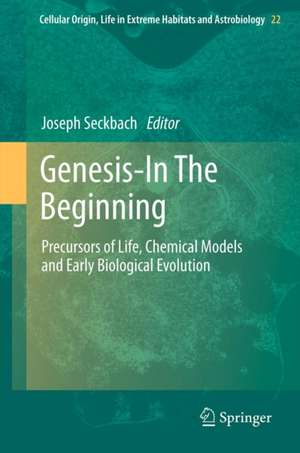Genesis - In The Beginning: Precursors of Life, Chemical Models and Early Biological Evolution: Cellular Origin, Life in Extreme Habitats and Astrobiology, cartea 22
Editat de Joseph Seckbachen Limba Engleză Hardback – 21 mar 2012
| Toate formatele și edițiile | Preț | Express |
|---|---|---|
| Paperback (1) | 1088.19 lei 38-45 zile | |
| SPRINGER NETHERLANDS – 23 aug 2016 | 1088.19 lei 38-45 zile | |
| Hardback (1) | 1252.76 lei 6-8 săpt. | |
| SPRINGER NETHERLANDS – 21 mar 2012 | 1252.76 lei 6-8 săpt. |
Din seria Cellular Origin, Life in Extreme Habitats and Astrobiology
- 18%
 Preț: 1683.66 lei
Preț: 1683.66 lei - 5%
 Preț: 1440.04 lei
Preț: 1440.04 lei - 18%
 Preț: 1839.32 lei
Preț: 1839.32 lei - 18%
 Preț: 1848.33 lei
Preț: 1848.33 lei - 18%
 Preț: 1839.32 lei
Preț: 1839.32 lei - 18%
 Preț: 1222.27 lei
Preț: 1222.27 lei - 18%
 Preț: 1232.26 lei
Preț: 1232.26 lei - 18%
 Preț: 2098.03 lei
Preț: 2098.03 lei - 18%
 Preț: 1228.29 lei
Preț: 1228.29 lei - 18%
 Preț: 2111.46 lei
Preț: 2111.46 lei - 24%
 Preț: 1076.36 lei
Preț: 1076.36 lei - 18%
 Preț: 1828.11 lei
Preț: 1828.11 lei - 18%
 Preț: 951.14 lei
Preț: 951.14 lei - 18%
 Preț: 1219.94 lei
Preț: 1219.94 lei - 18%
 Preț: 1235.08 lei
Preț: 1235.08 lei - 18%
 Preț: 1263.01 lei
Preț: 1263.01 lei - 18%
 Preț: 956.50 lei
Preț: 956.50 lei - 18%
 Preț: 956.03 lei
Preț: 956.03 lei - 18%
 Preț: 1234.46 lei
Preț: 1234.46 lei - 18%
 Preț: 1122.58 lei
Preț: 1122.58 lei - 15%
 Preț: 646.11 lei
Preț: 646.11 lei - 18%
 Preț: 1840.91 lei
Preț: 1840.91 lei - 18%
 Preț: 1231.16 lei
Preț: 1231.16 lei - 18%
 Preț: 1251.50 lei
Preț: 1251.50 lei - 18%
 Preț: 961.41 lei
Preț: 961.41 lei
Preț: 1252.76 lei
Preț vechi: 1527.75 lei
-18% Nou
Puncte Express: 1879
Preț estimativ în valută:
239.71€ • 250.28$ • 198.39£
239.71€ • 250.28$ • 198.39£
Carte tipărită la comandă
Livrare economică 04-18 aprilie
Preluare comenzi: 021 569.72.76
Specificații
ISBN-13: 9789400729407
ISBN-10: 9400729405
Pagini: 460
Ilustrații: XXXIX, 934 p.
Dimensiuni: 155 x 235 x 58 mm
Greutate: 1.45 kg
Ediția:2012
Editura: SPRINGER NETHERLANDS
Colecția Springer
Seria Cellular Origin, Life in Extreme Habitats and Astrobiology
Locul publicării:Dordrecht, Netherlands
ISBN-10: 9400729405
Pagini: 460
Ilustrații: XXXIX, 934 p.
Dimensiuni: 155 x 235 x 58 mm
Greutate: 1.45 kg
Ediția:2012
Editura: SPRINGER NETHERLANDS
Colecția Springer
Seria Cellular Origin, Life in Extreme Habitats and Astrobiology
Locul publicării:Dordrecht, Netherlands
Public țintă
Upper undergraduateCuprins
PRELIMINARY SECTION: Pathways to “Genesis - In the Beginning: Precursors of Life, Chemical Models and Early Biological Evolution”.- Introduction to Genesis - In The Beginning.-Foreword.-Origins of Life - Keeping Options Open.- PART 1. CHEMICAL EVOLUTION: The Prebiotic Chemistry of Alternative Nucleic Acids.- Cooptive Evolution of Prebiotic Chemical Networks.- Origin and Evolution of Self-Replicating Polymers on Mineral Habitats.- Mathematical Models of Prebiotic Replication: A Primer for Experimentalists.- Life without Carbon; Rob Hengeveld.- [GADV]-Protein World Hypothesis on the Origin of Life.- Reality of the Emergence of Life-Like Systems from Simple Prebiotic Polymers on Primitive Earth.- The Photobiological Regime in the Very Early Earth and the Emergence of Life.- Prebiotic Formation of Peptides: A Markov Chain Approach.- Atomic Structural Templates of the Earliest Life on Earth: Vibration and Lightning Experiments with Quartz and Amino Acids.- Chemical Evolution in Open Space: A Link to the Origin of Life.- The Prebiotic Chemistry of Nitrogen and the Origin of Life.- PART 2. THE ROLE OF PHYSICS AND GEOPHYSICS IN THE ORIGIN AND EVOLUTION OF LIFE: Moving ‘Far from Equilibrium’ in a Prebiotic Environment: The Role of Maxwell’s Demon in Life Origin.- Life from Interface.- Breaking the Paradigm: The Pattern of Life.- Cyberbiogenesis and the EvoGrid: a 21st Century Grand Challenge.- Constructive Approaches for the Origin of Life.- Origin of Life by Thermodynamic Inversion: A Universal Process.- Life Explained by Heat Engines.- Computational Simulations of Prebiotic Processes.- The Cometary Hydrosphere.- In Situ, High Spatial Resolution Techniques in the Search for the Origin of Life.- PART 3. THE ROLE OF SYMMETRY, INFORMATION AND ORDER IN THE ORIGIN OF LIFE: Disorder to Order, Non-Life to Life. In the Beginning There Was a Mistake.- The Role of Information and Order in the Origin of Life.- The Origin of First Peptides on Earth – From AminoAcids to Homochiral Biomolecules.- Chemical Models for the Origin of Biological Homochirality.- Absolute Asymmetric Reactions and the Origin of Biological Chirality.- Energy-Driven Evolution of Prebiotic Chiral Order (Lessons from Dynamic Systems Modelling).- PART 4. PANSPERMIA: Recurrent Dreams of Life in Meteorites.- Are We from Outer Space? A Critical Review of the Panspermia Hypothesis.- Origin of Life and Panspermia.- PART 5. THE FIRST STEPS OF CELLULAR EVOLUTION: The Dimeric Proto-Ribosome Within the Modern Ribosome.- Oceanic Arginine Translator: The Origin of Life and Early Evolution of the Genetic Code.- Tidal Cycling and the Origin of the Genetic Code: Implications for Cellular Life.- Heterotrophic Model Protocells.- A Symbiogenic Way in the Origin of Life.- Horizontal Gene Transfer and the Tree of Life.- On the Vesicular Origin of the Cell Cycle.- Hypothesized Micro-Environments for the Origin of Microbial Life on Earth.- PART 6. THE DISTRIBUTION OF LIFE IN THE SOLAR SYSTEM AND ELSEWHERE IN THE COSMOS: What can Life on Earth Tell Us about Life in the Universe?.- Potential for Life in the Saturn System.- Energy Sources for, and Detectability of, Life on Extrasolar Planets.- Environments Habitable by Extremophiles on Earth, the Solar System and Elsewhere.- PART 7. HISTORY AND FRONTIERS OF ASTROBIOLOGY AND THE HUMANITIES: Cultural Implications of the Search and Eventual Discovery of a Second Genesis.- The Concept of Chemical Evolution before Oparin.- A History of Origin of Life Ideas from Darwin to NASA.
Textul de pe ultima copertă
This book deals with the Origin of Life on Earth and planets, which is currently a very “hot” topic dealt with at several international meetings, conferences and workshops by various societies and groups. The current volume is number 22 of the “Cellular Origin, Life in Extreme Habitats and Astrobiology” series (COLE) published by Springer. The contributors review new data in this field, following current studies from gene and molecular to macro levels. The extremophiles – microorganisms living at the edge of Life under very severe conditions (from our anthropocentric view point) - may point out possibilities of existing Life forms on other planets and satellites.
In eight sections and fifty chapters, the seventy-five authors cover subjects such as chemical evolution, the function of geophysics in Life’s origin, the first steps of cellular evolution, Panspermia (the theory claiming that the source of Life is not from Earth but from Outer Space), possibility of extraterrestrial Life (Astrobiology), and the history of origin of Life on Earth and beyond.
This up-to-date book complements volume 6 (Origin Genesis, Evolution and Diversity of Life (2004) in the COLE series (ISBN: 978-1-4020-1813-8) published by Kluwer Academic Publishers.
Professor D. Deamer ends his Introduction with these words: Future progress in understanding the origin of life will involve simulations of prebiotic conditions that take this complexity into account. Some of the chapters in this book focus on specific aspects of the chemical and physical processes that would be involved in life's origins, while othersincorporate increments in complexity such as mineral surfaces and compartments. In a sense, each chapter represents a piece of a puzzle, and readers who take the time to read all the chapters may see unexpected patterns emerge that will give clues to solving the puzzle.
The primary audience for this book are general biologists, geologists, geneticists, astrobiologists and astrophysicists, and advance undergraduate and graduate students, researchers and teachers in those fields.
In eight sections and fifty chapters, the seventy-five authors cover subjects such as chemical evolution, the function of geophysics in Life’s origin, the first steps of cellular evolution, Panspermia (the theory claiming that the source of Life is not from Earth but from Outer Space), possibility of extraterrestrial Life (Astrobiology), and the history of origin of Life on Earth and beyond.
This up-to-date book complements volume 6 (Origin Genesis, Evolution and Diversity of Life (2004) in the COLE series (ISBN: 978-1-4020-1813-8) published by Kluwer Academic Publishers.
Professor D. Deamer ends his Introduction with these words: Future progress in understanding the origin of life will involve simulations of prebiotic conditions that take this complexity into account. Some of the chapters in this book focus on specific aspects of the chemical and physical processes that would be involved in life's origins, while othersincorporate increments in complexity such as mineral surfaces and compartments. In a sense, each chapter represents a piece of a puzzle, and readers who take the time to read all the chapters may see unexpected patterns emerge that will give clues to solving the puzzle.
The primary audience for this book are general biologists, geologists, geneticists, astrobiologists and astrophysicists, and advance undergraduate and graduate students, researchers and teachers in those fields.
Caracteristici
Genesis and evolution of Life with chemical, geological and biological data in one volume The book covers several aspects of Life on Earth and on Solar system and beyond The authors are competent and experts in their fields and present updated data from their research












